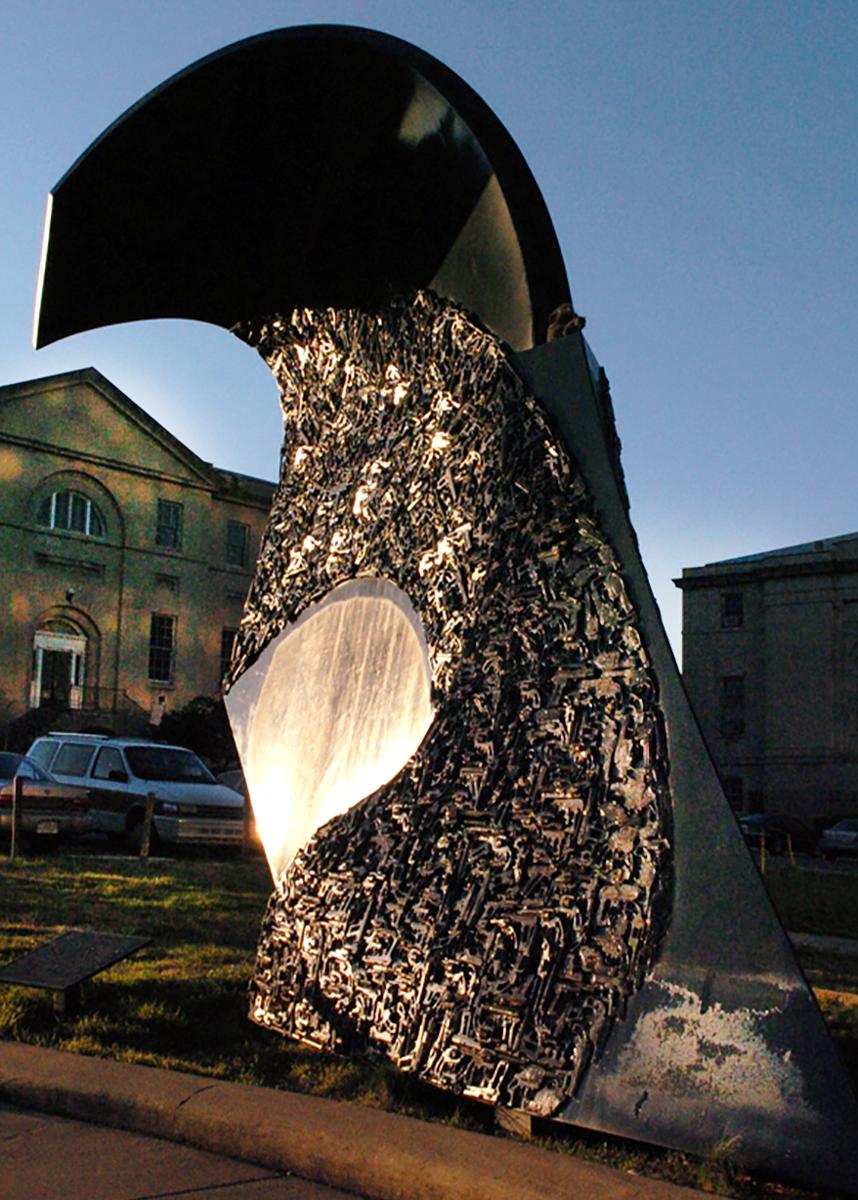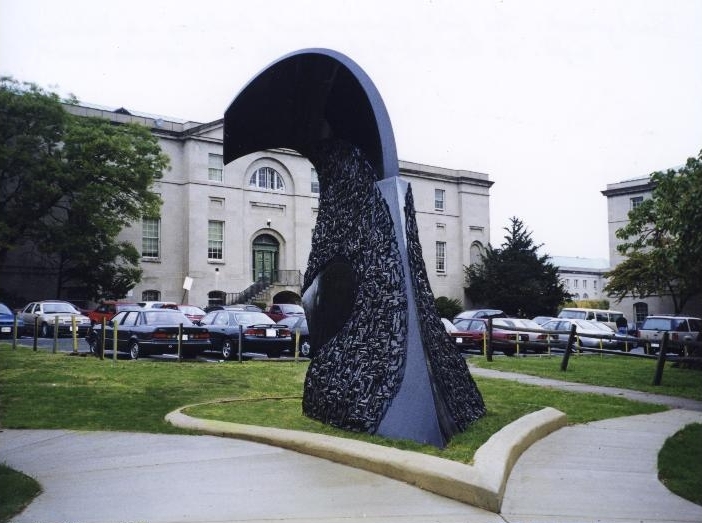December 15: Prince of Peace
♫ Music:
Day 13 - Friday, December 15
Title: Names of Jesus VI
Scripture: Isaiah 9:6f
“Prince of Peace”
Poetry:
Salus Mundi
By Mary Coleridge
I saw a stable, low and very bare,
A little child in a manger.
The oxen knew him, had Him in their care,
To men He was a stranger.
The safety of the world was lying there,
And the world’s danger.
PRINCE OF PEACE
Carl Fredrik Reuterswärd’s Knotted Revolver both comforts and startles. Is it an image of safety or danger? A knotted revolver is harmless--but the person who can do the knotting is anything but. Just think of your favorite superhero movie where a two-bit criminal draws his gun and the superhero ties the barrel into a knot with a mere hand gesture. The next scene is a terrified criminal dropping the weapon and running for his life. Mary Coleridge offers a similar paradoxical vision when she looks to the manger and sees “the safety of the world lying there...and the world’s danger.”
We don’t often think of Jesus as dangerous--especially not baby Jesus. Baby Jesus is the stuff of lullabies and flannelgraphs. He is surely “the safety of the world”--but “all the world’s danger?”
Is Jesus dangerous?
Yes, indeed!
First, remember that danger can be more than just a physical threat. We often talk of dangerous ideas. Jesus had a lot of those. He was dangerous to the Pharisees and Sanhedrin because he threatened their power. He was dangerous to the status quo because he taught women, touched lepers, befriended sinners, washed feet, healed on the wrong day, and ate with the wrong people. The quo didn’t have much status left by the time Jesus was done with it.
Peace doesn’t sound dangerous until Jesus gets a hold of it. Refusing to fight for one’s rights; refusing to return insult for insult, or injury for injury—this sounds dangerous! Likewise, consider commands to bless those who persecute you and turn the other cheek. Taken seriously these are frightening commands. What would happen if I did not defend myself? If I turn the other cheek, won’t someone just slap me silly?
Safe peace is peace by conquest not surrender. If there is going to be surrender, let it be the other guys! Conquest settles the power structure in our favor. But what about a peace born of weakness? Peace secured by a baby lying in a manger is unnerving--especially when the manger lies in the shadow of a cross. Jesus conquered death by suffering it. He promises power to his followers, but a power that is made perfect in weakness. Even when the Book of Revelation foretells his ascension to the throne, it does so with the image of the Lamb Crucified rather than the Lion of Judah. The Lion seems safer.
What does this mean for us as followers of this Prince of Peace? At the very least, we should not be surprised when he works his peace in unexpected ways. We may pray for conquest, but we should not be surprised when he works through surrender. We may seek to be heard, but should not be surprised if instead we are called to listen. We pray for life, but he may work through death. We pray for deliverance, but sometimes it is the blood of the martyrs that is the seed of the church. Simply put, He offers a peace that passes understanding, not a peace we understand.
So perhaps our best Christmas prayer for peace, is simply a prayer of surrender to His unexpected ways. Those ways may include grace from unexpected sources, or those ways may pass through dangerous places; we may lie down in green pastures, or we may walk the valley of the shadow of death. Once we surrender, we need not fear, for He is with us. Emmanuel--God with us! Our peace is found in our proximity to Him-- whether on throne or cross or manger.
Prayer:
Lord, I surrender to your peace. Let me walk in your ways and embrace your will. Whether those ways are safe or dangerous, let me find peace in your presence, and comfort in your guidance, knowing that you will not leave me till you have brought me safely home.
Amen
Richard C. Langer
Professor of Biblical Studies and Theology
Director of the Office of Faith and Learning at Biola
About the Artwork #1:
Non-Violence or The Knotted Revolver, 2011
Carl Fredrik Reuterswärd
Bronze
Original made in 1980
Installed at the Memorial of Caen Museum
Caen, Normandy, France
This bronze sculpture of a Colt Python .357 Magnum revolver with a knotted barrel and the muzzle pointing upwards was made by Swedish artist Carl Fredrik Reuterswärd after his friend, singer-songwriter John Lennon, was murdered in 1980. Since 1993, the sculpture has been the symbol of The Non-Violence Project, a nonprofit organization that promotes social change through violence-prevention education programs. Initially placed in the Strawberry Fields Memorial in Central Park, New York, the sculpture then became one of the first artworks at the United Nations. UN Secretary General and Nobel Peace Laureate, Kofi Annan said: “The sculpture Non-Violence has not only endowed the United Nations with a cherished work of art; it has enriched the consciousness of humanity with a powerful symbol that encapsulates, in a few simple curves, the greatest prayer of man; that which asks not for victory, but for peace.” There are 30 copies of the sculpture around the world with the UN sculpture being the original. This copy is installed at the Mémorial de Caen, a museum and war memorial located in Normandy, France, commemorating World War II.
About the Artist #1:
Carl Fredrik Reuterswärd (1935-2016) was a Swedish artist who lived in Lausanne, Switzerland, and was a student of the French artist and filmmaker Fernand Legér. Reuterswärd’s work has been exhibited around the world. During his lifetime, he also published several collections of poetry. He was a professor of painting at The Academy of Fine Arts in Stockholm from 1965-1969. In 1974, he was a guest professor at Minneapolis School of Art, Minneapolis, Minnesota. In 1986, he was awarded the Prince Eugen Medal for painting, a medal conferred by the King of Sweden, for "outstanding artistic achievement."
About the Artwork #2:
Guns into Plowshares, 1997
Esther & Michael Augsburger
Steel and 3,000 handguns
19’ long x 16’ high
District of Columbia
Guns into Plowshares is a large sculpture of steel, in the sculptural shape of a plowshare created by Mennonite artists Esther K. Augsburger and her son, Michael. The sculpture was fashioned in 1995 from 3,000 guns collected by the District of Columbia Police in a buyback program funded by heavyweight boxing champ Riddick Bowe. The inspiration for the work was taken from Isaiah 2:4; “They shall beat their swords into plowshares, and their spears into pruning hooks: nation shall not lift up sword against nation, neither shall they learn war any more.”’ The Augsburgers raised the $100,000 to construct and install the statue, which for eleven years was located in the heart of downtown at the District of Columbia Police Headquarters. In 2008, when the downtown area was renovated, Guns into Plowshares was relegated to a storage yard next to a sewage treatment plant. It was reinstalled in 2011, in front of a police evidence facility in the southwest section of the District of Columbia.
About the Artists #2:
Esther Augsburger (b. 1930) graduated from Eastern Mennonite College with a BA in art and James Madison University with an MA in art and art education. She was instrumental in the organization of the International Artists’ Conferences in Moscow in 1996, and in Sophia, Bulgaria, in 2008. About her art and faith, Esther states: “I believe that we were created in the image of God and part of that image is to be creative. I believe that artists are given a gift of artistry, and even the process of creating it is worship because it is giving glory to God.”
Michael Augsburger (1954-2017), the son Myron and Esther Augsburger, graduated from Eastern Mennonite College where he also studied art. His adventurous spirit took him around the world to minister and provide humanitarian relief to people in India, Haiti and Indonesia.
About the Music:
“Sonata for Solo Violin, Native Informant: V. Lullaby for the Ex Soldat” from the album Mohammed Fairouz, Native Informant
About the Composer:
Arab-American composer Mohammed Fairouz (b. 1985) studied composition at the New England Conservatory and the Curtis Institute of Music, and currently lives and writes in New York City. Self-described as “obsessed with text,” Fairouz has written hundreds of art songs, dozens of song cycles, multiple operas, and continues to collaborate with countless librettists, authors, and poets to explore cross-cultural Middle Eastern themes and racial reconciliation. Native Informant, a collection of five movements for solo violin commissioned by Rachel Barton Pine, ends with the aching “Lullaby for the Ex Soldat.” In this tender movement evoking Armenian lullabies, the violin imitates a harp lulling an ex-soldier to sleep. According to Fairouz, this music comes from a deep love for the Arab World, and expresses his “deep yearning for healing and peace in uncertain times.”
About the Performer:
American violinist Rachel Barton Pine (b. 1974) began playing violin when she was 3, inspired by watching older girls perform music at her church. At age 10 she debuted with the Chicago Symphony, and eight years later became the youngest winner of the Johann Sebastian Bach International Competition in Germany. When she was 21, she was injured in a horrific train accident, but after a two-year recovery continued an international performance career. In addition to championing music of black composers and covering educational expenses of deserving young musicians through her own foundation, Barton Pine also supports humanitarian and music education efforts in developing countries.
About the Poet:
Mary Elizabeth Coleridge (1861–1907) was a British novelist and poet who also wrote essays and reviews. Coleridge grew up in a literary and artistic environment. She was the great-grandniece of Romantic poet Samuel Taylor Coleridge and the daughter of musically talented parents. She lived in a home frequented by distinguished family friends including Alfred, Lord Tennyson, Anthony Trollope, John Ruskin, and Robert Browning, among others. Coleridge wrote poetry under the pseudonym “Anodos,” taken from George MacDonald’s central character in the fantasy novel Phantastes. Robert Bridges, the Poet Laureate, described her poems as “wondrously beautiful… but mystical rather and enigmatic.” Coleridge also taught grammar and literature to young women at the Working Women's College as part of her belief that it was her Christian duty to help the poor.
About the Devotional Writer:
Richard Langer is a Professor of Biblical Studies and Theology, and the Director of the Office of Faith and Learning at Biola University. He specializes in the integration of faith and learning, and has also published in the areas of bioethics, theology and philosophy. He has a passion for helping Christians of all ages understand the connection between the Gospel and the diverse facets of the created order in which we live. Prior to coming to Biola, he served for over twenty years as a pastor at Trinity Evangelical Free Church in Redlands, California. He is the author of the new book co-written with Biola Professor Tim Muehlhoff entitled, Winsome Persuasion: Christian Influence in a Post-Christian World published by IVP Academic.



_Caen.JPG)